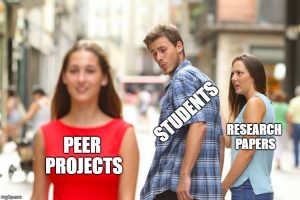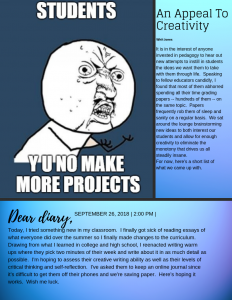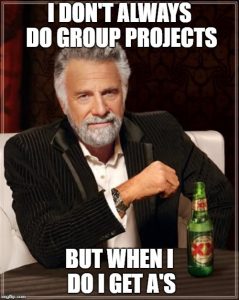A spooky reading.
Do you know what your students are saying about research papers?
They Say That….
A student’s ability to express themselves in an academic situation is all but reliant on the papers they produce.
All of us are familiar with the tried-and-true method of the research paper. A student picks a topic, picks a variety of sources and cobbles together some hopefully eloquent presentation on the subject. While arguably easier to grade based on limited scope of the genre and media, there is another, lesser chosen attempt at establishing retention: the group project.
Peer projects: Useful or Useless?
Mention a group project to any class of students and the results will usually be the same: split between the people that think they won’t have to do much work and the people that know they’ll be doing most of the work, either due to their group’s work ethic or not. However, group projects actually have a lot going for them from a teaching perspective.
According to Carnegie Mellon University, some benefits of group projects include:
Break complex tasks into parts and steps
Plan and manage time
Refine understanding through discussion and explanation
Give and receive feedback on performance
Challenge assumptions
Develop stronger communication skills.
Speaking as a Longwood student who’s very familiar with both sides of the argument, I can attest to the fact that for as much as I enjoy working alone being in a group project for the better part of a semester has allowed me to flex my communication skills, hold myself accountable for my actions, and learn to take feedback better.
So, should you risk it?
Well, I can’t decide that for you.
It’s easy to stand by the tested methods of the paper and ignore the idea of creativity and accountability presented in group projects. However, give your students the ability to hone their own skills and showcase their talents creatively and with others is — in one student’s opinion — always worth the risk.
For more articles pertaining to pedagogy, please see Cult of Pedagogy: A Blog
For more information on crafting digital texts, please consult Crafting Digital Writing by Troy Hicks
How to incorporate different genres in digital writing
Genres:
- flowchart (brainstorming)
- memes
- diary
Audience: Dr. Smith, classmates, future employers
Media: blog
Purpose: demonstrate a) your understanding of teaching digital writing using Hicks’s model b) your ability to create digital texts
Situation:
- reflected personal writing style
- content should include how would use what learned to teach future students; talk in terms of what you want NOT to do?
- Title must cover entire assignment; title could be a question from journal
It has been said by many a stressed out college student that research papers and worksheets are tedious, taxing, and not altogether helpful in retention of materials. To circumvent this, a new wave of teachers and educators are pushing for a change: incorporate digital media in new and creative ways to showcase not just their comprehension, but also their unique skills. Take this blog, for example. By having a digital repository of my literary collection I am able to show my growth as a writer and perhaps pitch my professionalism to future employers.
Imbed audio of me reading something already on the blog
(Honestly, Dr. Smith, your instructions were a little vague and I’m not sure if I’ve met the goal of this assignment. My apologies for my idiocy.)
Celebrate collaborative learning!
[Image description: Well-dressed man poses for picture with a beer. Image text reads: “I don’t always do group projects, but when I do I get A’s.]
Sick of research papers? Bored of worksheets?
Studies show that students are more engaged in their projects when given a chance to collaborate with others and are encouraged to create with creativity. While not all students are keen to collaborate with their peers, studies show that “…..” [Robb citation needed]
Rather than sifting though piles upon piles of research papers and worksheets, teachers should be encouraging collaboration in group projects. Hands-on interactive learning with lots of discussions allow students to recall knowledge, expand on ideas, and bounce ideas off of each other.


